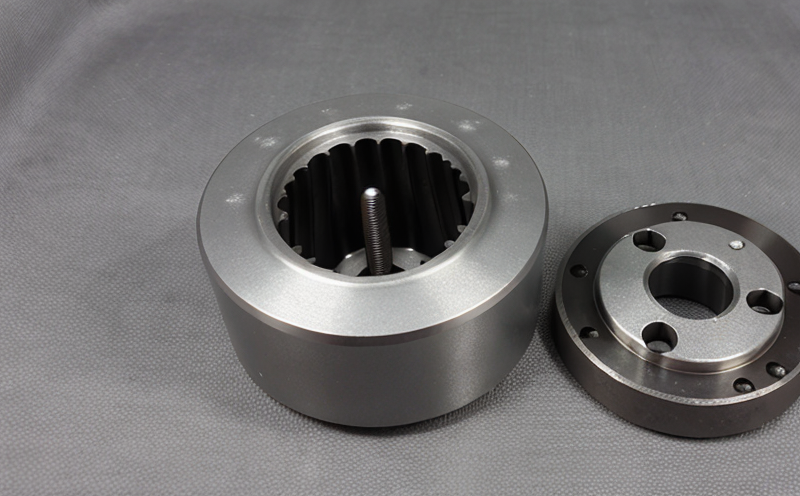ISO 3923-1 Apparent Density of Metal Powders by Funnel Method
The apparent density is a critical parameter in powder metallurgy and additive manufacturing, providing insight into the compactibility of metal powders used for forming complex geometries. The ISO 3923-1 standard outlines a method to measure this property using the funnel technique. This test is essential for ensuring that the powder meets the required specifications for its intended application.
The process involves filling a specified volume with the powder, compacting it into a mold, and then measuring the mass of the filled volume. The apparent density is calculated as the ratio of this mass to the known volume. This parameter influences the flowability, compaction behavior, and final properties of the compacted material in various manufacturing processes.
For instance, in additive manufacturing, accurate powder characteristics are crucial for ensuring consistent print quality and part performance. In metal powder metallurgy, the apparent density can affect the porosity and mechanical strength of the final product. Thus, this test is not only a compliance requirement but also a key step in optimizing production processes.
The funnel method is particularly suited for powders with relatively low flowability or those that tend to settle irregularly. It provides a reliable measure of the powder's bulk density under controlled conditions. This standard ensures consistency across different lots and batches, which is vital for maintaining product quality and reliability.
Understanding the apparent density through this method helps in identifying potential issues such as segregation during handling or inconsistencies in the manufacturing process. By adhering to ISO 3923-1, manufacturers can ensure that their products meet the required specifications and perform consistently across different environments and applications.
- Q: What is the significance of apparent density in powder metallurgy?
- A: Apparent density is crucial for optimizing the performance of metal powders used in additive manufacturing and powder metallurgy. It influences flowability, compaction behavior, and final product properties.
Why It Matters
The apparent density test is fundamental in ensuring that metal powders meet the required specifications for their intended applications. In powder metallurgy, this parameter directly impacts the mechanical properties of the final product, such as strength and durability. For additive manufacturing, accurate powder characteristics are essential for consistent print quality and part performance.
Segregation during handling can lead to variations in apparent density within a single batch, which could result in inconsistencies in the final product. By measuring the apparent density using ISO 3923-1, manufacturers can identify and address such issues early in the production process. This ensures that the powder is uniformly compactible across all batches, leading to consistent performance and reliability.
Compliance with this standard also helps in maintaining quality standards across different suppliers and manufacturing sites. It provides a common benchmark for evaluating powder characteristics, ensuring that the material meets the required specifications and performs consistently under various conditions.
Why Choose This Test
The ISO 3923-1 test is chosen because it provides an accurate and reproducible measurement of apparent density. This method ensures that the powder meets the required specifications for its intended application, thereby enhancing product quality and reliability.
The funnel technique used in this standard allows for a controlled environment where the powder's flowability and compactibility can be precisely measured. This is particularly important in industries like additive manufacturing and metal powder metallurgy, where small variations in powder characteristics can significantly impact the final product.
By adhering to ISO 3923-1, manufacturers can ensure that their products meet the required specifications consistently across different batches and environments. This not only enhances product quality but also ensures compliance with international standards. The test is widely recognized and accepted in the industry, providing a level of confidence in the powder's performance.
The reliability of this test makes it an indispensable tool for quality managers and R&D engineers looking to optimize production processes and ensure consistent product performance. It provides a clear path towards identifying potential issues early on, thereby minimizing costly rework and downtime.
Quality and Reliability Assurance
The ISO 3923-1 apparent density test plays a vital role in quality assurance by providing accurate measurements that are essential for meeting product specifications. This standard ensures that the powder is uniformly compactible, which is crucial for maintaining consistent performance across different batches.
- Q: How does ISO 3923-1 contribute to quality and reliability assurance?
- A: By providing accurate measurements of apparent density, this standard ensures that the powder meets the required specifications consistently. This uniformity enhances product performance and reliability.
The test helps in identifying potential issues such as segregation during handling or inconsistencies in the manufacturing process. Early detection of these issues allows for timely corrective actions, thereby minimizing costly rework and downtime.
Compliance with ISO 3923-1 ensures that the powder meets international standards, providing a level of confidence in its performance across different environments and applications. This reliability is essential for maintaining high-quality products that meet customer expectations and regulatory requirements.





